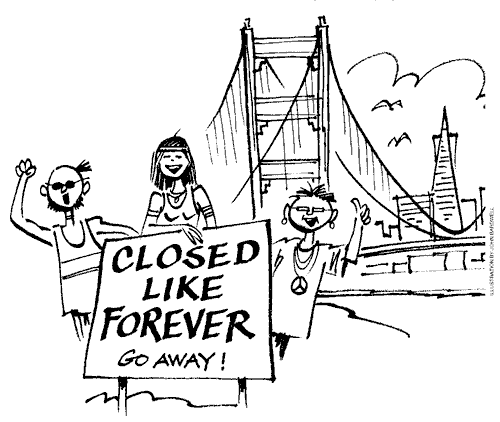Radical enviros are relentless in attempting to remove human beings and our trappings from huge tracts of the American West. Among the trial balloons always afloat are the removal of cattle from federal lands, draining reservoirs, protecting large areas through wilderness designation or by bestowing monument status, and even depopulating the Great Plains to create a Buffalo Commons.
Oddly enough, these initiatives seem to be concentrated in rural, remote areas where there are few people and, relatively speaking, human impact on the land has been minimal. Which means that any improvement that might result will be small and, at the end of the day, make very little difference.
Why settle for incremental gains? Why not apply these concepts to areas where they will effect great change and make a noticeable difference?
Take San Francisco, for example. Before it was San Francisco, before it was Yerba Buena, even before it was dubbed Nova Albion, the area now occupied by The City was a pristine ecosystem of inlets, tidal pools, beaches, dunes, wetlands, creeks, and gentle hills; a delicate environment where a plethora of plants, animals, birds, and sea creatures coexisted in a complex and delicate balance. Unfortunately, ever since colonists showed up in 1776 and built the Presidio and Mission Dolores, the balance has been seriously out of whack. The effects are not confined to the local area, either--among other things, San Francisco was responsible for flooding the Hetch Hetchy Valley in a misguided effort to quench The City’s insatiable thirst.
It’s time to restore the balance.
It will not be easy. It will be expensive. It will take time. It will require creative interpretations of laws and regulations. But by restoring San Francisco to its preplundered con�di- di- tion, we can set the example and the standard to which others can look for inspiration in repairing the damage to other areas despoiled by humankind. There is much to be done and space is not sufficient to catalog all of San Francisco’s sins or suggest remediation. But you’ll get the idea.
One cannot overstate the environmental impact of The City. Into its miniscule 49 square miles, San Francisco jams more than 750,000 full-time residents! But that’s just the beginning--more than a quarter-million others
show up for work every business day. Imagine, if you can, the amount of water these million-plus people pollute, the air they befoul, the waste they create, the resources they tax. But it doesn’t end there! No! Each year, more than 16.5 million tourists show up to compound the problem. The first step, of course, must be to forbid all these people from entering The City so the restoration work can proceed.
Then there are all those buildings to bulldoze. From the ersatz pyramid and other skyscrapers from the age of exhibitionist architecture to the “painted ladies” of the Victorian era when robber barons ruled the earth, they’ve all got to go. We must restore the skyline that greeted Juan Manuel de Ayala and others aboard the San Carlos, the first ship to enter the Bay, way back in 1775.
We must restore the waterfront. Where once waves lapped gently against a meandering shoreline, there are now only artificial right angles created by concrete and steel and timber and rip-rap. Rip it all out, and rely on ancient maps to re-create the original contours.
Restore the wetlands. The entire marina district was a thriving tidal marsh until landfilled with rubble from the 1906 earthquake in a misguided effort to create more property for real estate developers to exploit. All the debris must be removed if we hope to recapture the fragile ecosystem that once flourished here. This will, of course, necessitate rebuilding the many creeks which once flowed through San Francisco to feed freshwater into the marsh, diluting seawater and creating a unique environment. Again, old maps can guide us in determining the courses of these forgotten streams.
The Golden Gate must appear on any list of mitigation projects. Restoring the natural beauty and scenic vistas of this rugged gateway between the sea and the bay will, of course, necessitate removal of that hideous bridge. First proposed in 1869 by a certified San Francisco madman--Norton I, Emperor of the United States and Protector of Mexico--the bridge was opened to traffic in 1937. Since then, more than a billion-and-a-half (that’s billion, with a b!) fossil-fuel-powered, greenhouse-gas-emitting vehicles have crossed over. The environmental impact of these gas guzzlers and the people who pilot them defies all imagination. The San Francisco-Oakland Bay Bridge, too, must come down. The busiest toll bridge in the world, this eyesore and despoiler carries more than a quarter-of-a-million vehicles daily.
That’s just the beginning. Much work will remain. But we have to start somewhere. Naturally, the economic impact of decommissioning San Francisco will be widespread and long lasting. The effect on the emotional and cultural lives of the people who live and work in The City will be considerable. Tourism may, for a time, suffer. Surely, though, it will all be worth it if we can, in fact, restore the land to its pristine condition for the enjoyment (from a distance, of course) of future generations.
Why mess around in the isolated areas of the rural West where we can accomplish so little, when we can take this tack and effect radical change? John Muir and the 181 other like-minded visionaries who founded the Sierra Club in San Francisco in 1892 would, no doubt, applaud our efforts.
Rod Miller writes poems and stories about cowboys and the West. He is a member of Western Writers of America.


